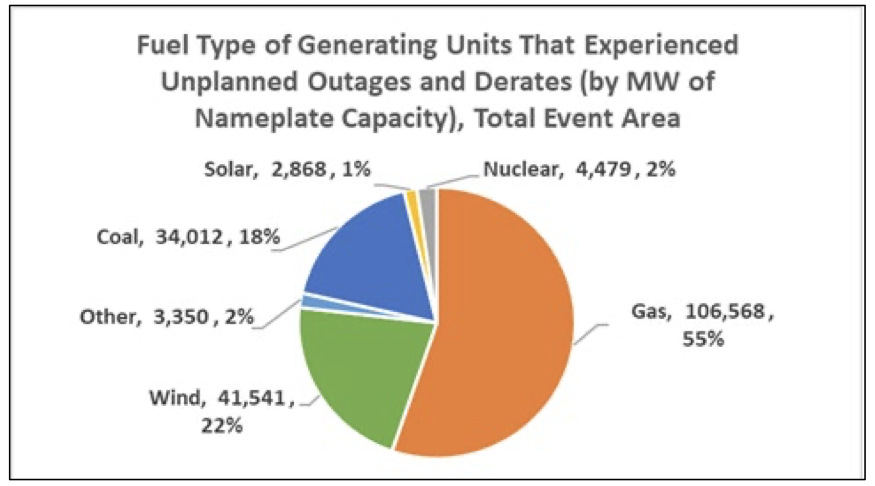With autumn arriving in much of the US, it won’t be long before parts of the country start experiencing cold weather again. Texas residents can be forgiven for the thought triggering a bit of PTSD, given that last winter saw the near-collapse of the state’s power grid, leaving many residents without any power for several days of below-freezing weather.
A long list of factors contributed to the mess, and in the immediate aftermath, it was difficult to understand their relative importance. But now, grid regulatory and governance groups have put together a preliminary report on the event, along with some recommendations for avoiding future calamities. A central conclusion is that the grid failure was tightly coupled to the failure of the natural gas supply—in part because natural gas processing facilities were among the places that saw their power cut.
The basic stats
The preliminary report has been put together by the Federal Energy Regulatory Commission (FERC) in combination with the North American Electric Reliability Corporation, a nonprofit set up by utilities to help set standards and practices that keep the grid stable. The draft itself isn’t being released at this point, but the two have posted a detailed presentation that describes the report’s contents. A final version will be released in November.
The outline of February’s grid problems is well understood: a severe cold snap raised demand at the same time as it caused failure of many of the generating sources in the area affected. The problems struck a number of states, but only Texas’ ERCOT grid suffered severe failures. The neighboring Southwest Power Pool suffered five hours when its demand exceeded its generating capacity, But, because of its tight integration into neighboring grids, it was able to call upon 13 gigawatts of generation capacity in states farther east.
Texas’ grid is poorly integrated into the rest of North America, so it didn’t have much help. As a result, demand exceeded capacity for three consecutive days, with the largest deficit being 20 GW. For over four minutes, the ERCOT grid’s frequency dropped from the standard 60 Hz to 59.4 Hz. Had ERCOT stayed at that frequency for five more minutes, additional generating sources would have tripped offline, sending all of ERCOT into a cascading blackout.

The largest single cause of failures during the event was frozen equipment, which ranged from individual gauges and instruments on large plants to the icing up of wind turbine blades. This accounted for 44 percent of the failures of generating equipment. Mechanical failures accounted for another 20 percent. Between the two was a failure of fuel supplies, accounting for nearly a third of the failures. And “fuel supplies” here primarily means natural gas.
When the gas doesn’t flow
During the peak of the cold snap, Texas saw natural gas production drop by 71 percent. Processing that natural gas for distribution dropped by a staggering 82 percent. Part of that is definitely the drop in supply. But clearly not all of it, given that the processing bottomed out two days before supply did. There were multiple causes of failure, including freezing of equipment and mechanical failures due to the cold.
But a major problem was loss of power to the gas distribution and supply system. Apparently, Texas grid operators had taken no steps to identify natural gas facilities and prioritize power delivery to them when starting the rolling blackouts. “Most natural gas production and processing facilities surveyed were not identified as critical load or otherwise protected from load shedding,” the report indicates.
This started something of a snowball effect. As processing and handling equipment lost power, the supply of natural gas dropped, which caused gas-fired power plants to shut down, cutting the electricity supply further, and potentially cutting off even more of the gas infrastructure. As of right now, the full extent of the power cuts to the natural gas infrastructure isn’t clear, and it’s not certain we will know by the time of the final report.
The to-do list
The report makes 28 recommendations for changes in response to these failures, nine of them termed key recommendations. The most significant of these is the recommendation to revise the NERC Reliability Standards, which indicate what’s expected from North American grid operators. The revisions include having new plants built to handle operating temperatures that include extreme weather events experienced at that location and to retrofit existing sites accordingly. Generators would also be expected to inform grid operators of how much capacity will be available based on forecasted weather conditions.
Other Reliability Standard revisions should ensure that natural gas infrastructure should be protected during load-shedding events and that any cold-driven failure on the grid trigger the production of a corrective-action plan.
Outside of modifying the Reliability Standards, a number of other recommendations focus on natural gas supplies. Any facilities that collect or process natural gas are advised to have a cold-weather plan as well as heating and backup power supplies. Forecasts of cold weather should also trigger inspections of these systems.
Beyond these concrete recommendations, there’s a long list of things that should be studied. One of the simplest is that ERCOT should consider having stronger interconnections with the surrounding grid, which proved critical in preventing widespread failures in neighboring states.
Of course, many of these recommendations could have been made the last time ERCOT saw a major failure, roughly a decade earlier. That failure was also bad enough to trigger an analysis and recommendations by FERC. Finalizing the report in November will be much less important than ensuring its recommendations lead to actions in the years that follow. Fortunately, it seems that the head of FERC recognizes this. There was a similar inquiry after Texas experienced extreme cold weather in 2011, but those recommendations were not acted on,” FERC Chairman Rich Glick said. “We can’t allow this to happen again. This time, we must take these recommendations seriously, and act decisively, to ensure the bulk power system doesn’t fail the next time extreme weather hits.”

